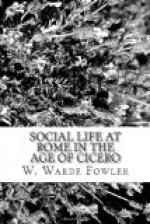[Illustration: PLAN OF THE VILLA OF DIOMEDES. From Man’s Pompeii.]
This villa was in or close to the little town, and therefore did not give him the quiet he liked to have for literary work. It would seem that the bore existed elsewhere than at Rome; for in a short letter written from Formiae in April 59, he tells Atticus of his troubles of this kind: “As to literary work, it is impossible! My house is a basilica rather than a villa, owing to the crowds of visitors from Formiae ... C. Arrius is my next door neighbour, or rather he almost lives in my house, and even declares that his reason for not going to Rome is that he may spend whole days with me here philosophising. And then, if you please, on the other flank is Sebosus, that friend of Catulus! Which way am I to turn? I declare that I would go at once to Arpinum, if this were not the most, convenient place to await your visit: but I will only wait till May 6: you see what bores are pestering my poor ears."[402]
But his Campanian villas would be almost as easy to reach as Arpinum, if he wished to escape from Formiae and its bores. To the nearest of these, the one at or near Cumae, it was only about forty miles’ drive along the coast road, past Minturnae, Sinuessa, and Volturnum, all familiar halting-places. Of this “Cumanum,” however, we know very little: that volcanic region has undergone such changes that we cannot recover the site, and its owner never seems to have felt any particular attachment to it. It was in fact too near Baiae and Bauli to suit a quiet literary man; the great nobles in their vast luxurious palaces were too close at hand for a novus homo to be perfectly at his ease there. Yet near the end of his life Cicero added to his possessions another property in this neighbourhood, at or near Puteoli, which was now fast becoming a city of great importance; but this can be explained by the fact that a banker of Puteoli named Cluvius, an old friend of his, had just died and divided his property by will between Caesar and Cicero,—truly a tremendous will! Cicero seems to have purchased Caesar’s share, and to have looked on the property as a good investment. He began to build a villa here, but had little chance of using it. It may have been here that he entertained Caesar and his retinue at the end of the year 45,[403] as described by him in the famous letter of December 21 (ad Att. xiii. 52); when two thousand men had somehow to be provided for, and in spite of literary conversation, Cicero could write that his guest was not exactly one whom you would be in a hurry to see again.




